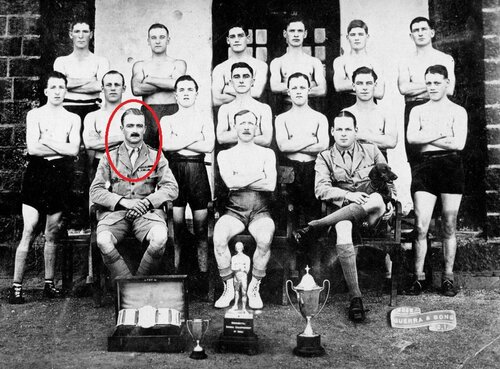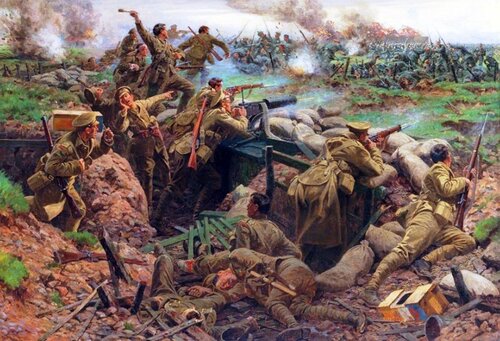Auction: 22001 - Orders, Decorations and Medals
Lot: 407
(x) The superb Great War C.M.G., D.S.O. group of seven awarded to Major-General B. J. Majendie, King's Royal Rifle Corps, who was present aboard the sinking of the Warren Hastings as a young Subaltern, was taken a Prisoner during the Boer War
Majendie led the 4th Battalion on the Western Front in 1915, an interlude which included his unit becoming the first unit to be attacked by gas besides being the senior of just three Officers of the 4th Battalion to survive the Battle of Frezenberg Ridge, 8 May - 10 May 1915; duly rewarded with the D.S.O., Majendie thence carved out a fine record whilst in higher command still in Salonika
The Most Distinguished Order of St. Michael and St. George, C.M.G., Companion’s neck Badge, silver-gilt and enamel; Distinguished Service Order, G.V.R., top riband bar adapted for mounting; Queen's South Africa 1899-1902, 3 clasps, Talana, Orange Free State, Transvaal (Capt: B. J. Majendie. K.R.R.C.); King's South Africa 1901-02, 2 clasps, South Africa 1901, South Africa 1902 (Capt: B. J. Majendie. K.R.R.C.); 1914-15 Star (Major B. J. Majendie. K. R. Rif: C.); British War and Victory Medals, with M.I.D. oak leaves (Brig. Gen. B. J. Majendie.); France, Republic, Legion of Honour, breast Badge, with rosette, gold and enamel, with poincon mark to reverse downward tassel, mounted as worn, ribands rather frayed, very fine (8)
C.M.G. London Gazette 1 January 1919 (Salonika).
D.S.O. London Gazette 14 January 1916.
French Legion of Honour London Gazette 21 July 1919.
Bernard John Majendie was born at Elvetham, Hampshire on 27 April 1875 and was commissioned from the Royal Military College Sandhurst on 1 January 1896.
Warren Hastings
He was present with a handful of Officers of the 1st Battalion, King's Royal Rifle Corps aboard the Warren Hastings at Cape Town on 6 January 1897, bound for Mauritius.
On board the Warren Hastings were 526 members of the King’s Royal Rifle Corps, 510 members of the 2nd Battalion York and Lancaster Regiment, and 25 members of the 2nd Battalion Middlesex Regiment, together with 20 women, 10 children, and 253 crew, totalling 1,244 people. A good passage was had until the morning of 13 January, when the glass fell and the wind shifted to the south. Despite reduced visibility there was no cause for concern and that night the troops went untroubled to bed. At about 2.20am on 14 January, a violent shudder was felt throughout the ship, as the Warren Hastings struck a rock off the coast of Réunion. Orders were given for the Rifles to fall in on the port side and the York and Lancasters on the starboard side. Through the torrential rain the ship’s Officers perceived that the vessel was aground and that it was possible to disembark by ropes on to the rocky coast. At 4.15am the ship began to heel to starboard. Twenty minutes later the electric lights went out. Thus by 5.00am those men on the starboard side, some in total darkness, were standing knee deep in water. The list gradually increased until the Captain himself thought the ship would turn over. Nevertheless the discipline for which the British soldier is famed prevailed, and the disembarkation was accomplished without a single fatality. The only lives lost during the whole episode were those of two natives who ran amok and jumped overboard. One Officer present later wrote:
‘Personally I look upon the whole business as one of the most creditable things to the British Army which has ever occurred, and without invidious comparison quite as creditable as the Birkenhead, for in the latter, if we are to believe the pictures, the men were at least all on deck, whilst on the Warren Hastings they were between decks, and quite unable to see what was going on.’
After a brief stay on Réunion, Majendie arrived in Mauritius with the rest of his comrades aboard the S.S. Lalpoora on 18 January 1897.
Boer War - Prisoner
He would serve during the Boer War (Queen's Medal & 3 clasps, King's Medal & 2 clasps), including at the Battle of Talana. Majendie also served attached to the 13th & 25th Battalion, Mounted Infantry from 14 June 1900 and as recalled in The History of the Prince of Wales' Civil
Service Rifles:
'Captain Majendie’s experiences in the South African war had been somewhat unique and unfortunate. Whilst accompanying a troop of cavalry sent out as a patrol from Ladysmith on the day that war was declared, the party were surrounded and captured by the enemy and held prisoners in Pretoria until that place was taken by General Roberts in the following year.'
He was thence made Adjutant of the Prince of Wales' Civil Service Rifles in November 1902, their History recalls:
'Captain Majendie was the first Adjutant which the Corps had secured from the regular Regiment of which it formed a Volunteer Battalion; and by his efforts and instruction the Battalion became “riflemen,” and adopted rifle drill and customs. But the fact that officers were always trained at the Guards’ Schools of Instruction, where the drill of the rifleman is unknown, was a drawback to this arrangement.'
Great War - Survivor of Frezenberg Ridge
By the outbreak of the Great War, Majendie was by this point a Major and proceeded to France with the 4th Battalion, serving from 21 December 1914. By Spring 1915 he was in command of the Battalion, which had endured the first use of chlorine gas on 22 April at Ypres and on 8 May 1915 was in the line east of Bellewaarde Lake for the Battle of Frezenberg Ridge during the Second Battle of Ypres. In relation to which, the following extract is taken from A Brief History of the King’s Royal Rifle Corps 1755-1915 by Sir Edward Hutton:
‘On Sunday night, the 3rd May, in consequence of the increasing pressure in the northern sector of the salient, the 80th Brigade was silently and skilfully withdrawn to a position nearer to Ypres. On the 5th a further withdrawal was made, and a position was taken up east of Bellewaarde Lake, still nearer to Ypres, with the Princess Patricia's Canadian Light Infantry and 4th Battalion in front line, and the 3rd Battalion in close support. On the 9th the 3rd Battalion relieved the gallant Canadians, who had been badly knocked about, while the 4th Battalion repulsed an infantry attack. On the 10th, after a terrific bombardment and a strong covering fire of machine guns and rifle fire, the enemy infantry essayed another advance, which was easily and promptly scotched by a well-directed rifle fire. Bellewarde Wood was now an impenetrable abattis, and the two Rifle Battalions were thus enabled to lend close and valuable assistance against the concentrated enemy attack to the south upon the neighbouring troops at Hooge. The 3rd and 4th Battalions in closest touch worked with great effect, and individual acts of gallantry were very numerous. By 6 p.m. the bombardment ceased, and the further advance of the enemy was effectively checked. By midnight the 4th Battalion was withdrawn and a bare remnant collected ; on the following day it was moved to a temporary bivouac, where the men lay down to sleep for a full night's rest after twenty-six days in the trenches, during a great part of which they had been closely engaged. The steadfast valor of the Riflemen was rewarded by a characteristic message from H.Q. Army Corps :
" The G.O.C. is lost in admiration at the way in which the 3rd and 4th Battalions have stuck out the pounding which they have received."
On the 14th the 4th Battalion, sadly reduced, was formed into a composite regiment with the remnant of the Princess Patricia's Canadian Light Infantry, and marched under Majendie again into the trenches until the 17th, when the Battalion moved to billets in the rear. On the 18th Major Widdrington rejoined the Battalion, and resumed command.’
Battle Honours of the King’s Royal Rifle Corps by T. N. F. Wilson quantifies the scale of the losses thus:
‘During the three days, May 8th - 10th, the 4th Battalion lost 15 officers and 478 other ranks. After the second enemy attack on May 10th, the 4th Battalion (3 officers and 98 other ranks, including C.O. and Adjutant) was formed into a Composite Battalion with Princess Patricia’s Canadian Light Infantry’.
Majendie - the C.O. - came out of the Battle with just 2nd Lieutenant Antrobus and Captain Ponsonby besides him. Swiftly embarked with his Battalion, he saw much service in Salonika and by war's end had risen to Major-General Commanding 65th Infantry Brigade, with no less than four 'mentions' (London Gazette 1 January 1916 (France), 6 December 1916, 28 November 1917 and 30 January 1919 (all Salonika), refers) to go with the two decorations.
Majendie reverted to command of the 3rd Battalion, King's Royal Rifle Corps in India in the early 1920s. By 1939 and happily retired, Majendie was living at Lynch House, Winchester. He died on 4 September 1959.
Subject to 5% tax on Hammer Price in addition to 20% VAT on Buyer’s Premium.
Sold for
£6,500
Starting price
£2400









